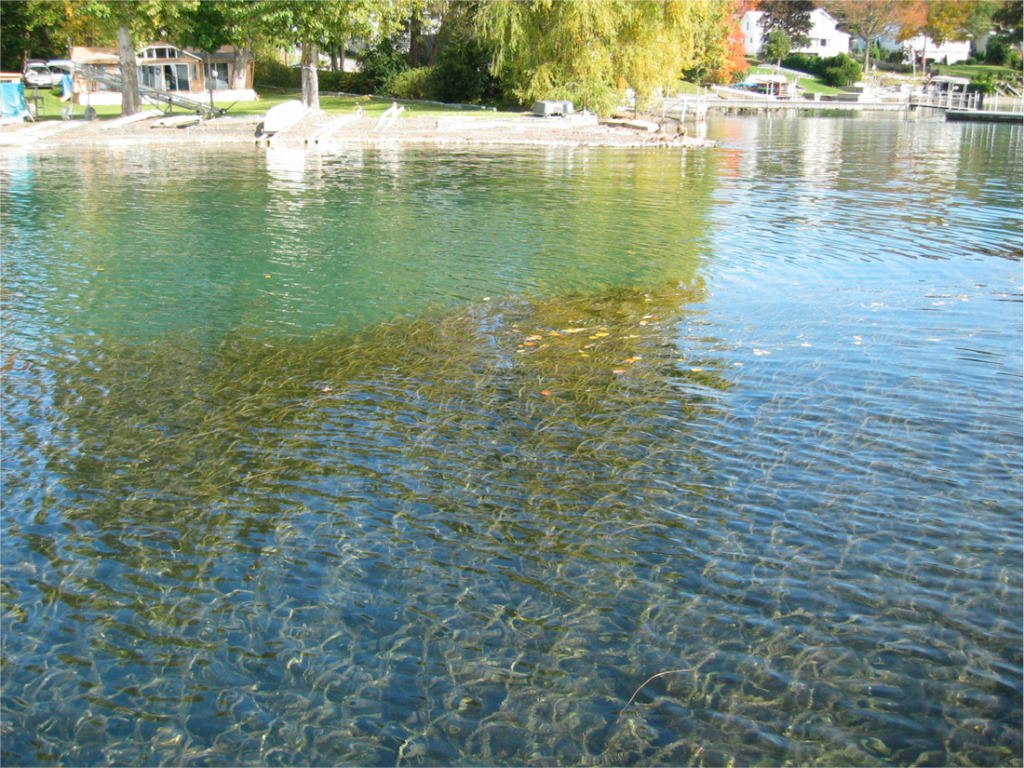ALERT: Harmful Algal Blooms (HABs) have been observed in the south eastern end of the lake. LEARN MORE
 Rapid Growth – It is a plant that grows rapidly reaching 20 or more feet in length during a single summer, extending right up to the surface. It also spreads horizontally by runners allowing it to cover more and more of the lake bottom. The stands thus formed are very dense with each plant tightly packed in with the others, leaving no room for any native plants to grow.
Rapid Growth – It is a plant that grows rapidly reaching 20 or more feet in length during a single summer, extending right up to the surface. It also spreads horizontally by runners allowing it to cover more and more of the lake bottom. The stands thus formed are very dense with each plant tightly packed in with the others, leaving no room for any native plants to grow.
Barrier – The stands in Skaneateles Lake were quite large normally running parallel to the shoreline, some 300-400 ft long and 20 – 80 ft wide. They were commonly found in water 10-12 ft deep and most often near the mouth of streams where sediment had accumulated (see below). As a consequence they acted as a barrier separating the near shore area from the deeper water. Prior to the appearance of these large stands of milfoil sediment carried into the lake had a tendency to work its way into deeper water where it became sequestered from the workings of the lake by settling to the bottom in deep water where it was relatively unaffected by wave action and other water movement. With milfoil acting as a barrier the sediment tended to stay near shore, depositing silt on the bottom and enriching the water with higher than normal levels of nutrients, which not only encouraged algal growth, but also provided more habitat for milfoil.
Nutrient Pump – Milfoil like most other plants obtains its nutrients from the sediments through the roots and transfers these nutrients up into the body of the plant where it forms new plant tissue. If the plant grows some 20 ft in a season then there has been a withdrawal of enough nutrients to allow for that amount of plant tissue to be formed. At the end of the season and over the winter and spring a great deal of this tissue breaks down releasing nutrients into the water where it can stimulate algal growth. In effect, milfoil acts as a kind of pump drawing nutrients up from the sediments and ultimately transferring the nutrients directly into the water.
Decaying vegetation – Wherever milfoil is abundant one of the concerns of lake property owners is the issue of decaying vegetation washing up on shore and rotting. This leads to an unpleasant shoreline and bad odors.
Impedes use of near shore – In addition to the decaying vegetation the presence of a large patch of milfoil inhibits the use of the near shore area. It prevents swimming, inhibits boating and fishing.
Relentless Spreading – If you put this all together with the fact that it was relentlessly spreading throughout the lake you can see why it alarmed the homeowners around the lake.
Declining property values – Several studies have also shown that property values decline by up to 15 or 20% when weedy vegetation forms in front of a lakeside residence. This has a direct economic impact on the property owner, but it also has a significant impact on the overall assessed value of the property. Lake front property is often the single largest source of property tax revenue for the municipalities in the region.
Aesthetics – The presence of milfoil in the near shore area of much of the lake would have changed the lake from the beautiful, clear pristine lake that it has been into a clogged, muddy, near shore with rotting vegetation piled up on the shoreline and extensive algal growth.
Summary – So, milfoil is clearly a threat to the lake ecosystem, a threat to the recreational use of the lake, and also a threat to the economic engine that helps this community sustain itself.